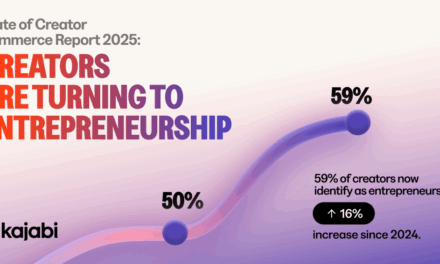What’s the news?
Two things are converging:
- Exponential growth is happening in the content creation industry, which is expected to hit $38.2 billion globally by 2030.
- More than 4M people have launched businesses in the United States (Q3 2020-Q12021). That’s almost double the previous three quarters, according to Census reports.
What do those two things indicate?
Though the research doesn’t directly connect the two, both stats indicate the potential for content entrepreneurship to grow significantly in the next few years.
That’s good news, right?
Yes, it is. But those two stats don’t reveal the number of content businesses that could fail. Two out of 10 startups (all industries) fail in the first year. By year five, half ceased to exist, according to Failory’s Startup Failure Rate: Ultimate Report 2021.
While the reasons vary, Failory’s study found 22% said marketing was a contributor to that failure.
And so?
Entrepreneurs often are eager to create their product, but they aren’t as excited about what it takes to promote their business. And that can mean disaster in the short or long term.
The Tilt Talk and Advice
Isn’t creating great content enough?
No, it isn’t. While great content that your audience wants is the foundation for success, you must still get attention for your content brand. And that requires deliberate external outreach.
How should content entrepreneurs promote themselves?
Think public relations – “a strategic communication process that builds mutually beneficial relationships between organizations and their publics.”
It’s a marketing-adjacent tactic that you, as a content creator, are primed to do: Create content (or content ideas) that resonate with a target audience. It also can be done on limited resources.
How does PR help?
External interest can help you reach people interested in your content but didn’t discover you through word of mouth or social media algorithms.
Coverage by external sites, influencers, and media outlets also elevates your social proof and credibility with brands. Sure, companies will look at your audience numbers and impact. But they also will appreciate that your content brand is recognized beyond your platforms. (That’s why entrepreneurs include media mentions and logos on their site.)
Any other benefits?
Just like brands see third-party mentions as validations, Google (and other search engines) does too. Having external links to your content brand’s site can help your rankings in Google search results.
Should you send a press release?
Yes and no. Unless you have big, timely news, a press release likely won’t get any traction with media. Instead, focus on pitches – a story angle around you or your business that is likely to be interesting and relevant to the media target’s audience. Unlike a press release, a pitch is unique to the outlet.
However, you may find SEO value by distributing a press release (with links) through an online wire service. (Cost usually is a few hundred dollars for a basic release. Price often is based on word count and provider.)
How should a content entrepreneur do PR?
Start by creating a list of 10 to 12 media, niche sites, influencers, etc., that would be most helpful to (1) extending your audience reach and/or (2) giving credibility to your content brand.
Pick two to three of the most realistic or low-hanging fruit. For example, a local media outlet likely is more interested in your story than The Wall Street Journal. A micro-influencer is more likely to connect with you than a Kardashian.
Customize your pitch for the recipient. Now is the time for your content creation skills to shine. Grab their attention with an intriguing intro. Get to the point quickly. Give them facts and figures to make a stronger case for your topic. And make it easy for them to engage with you (i.e., include all your contact information.)
What could be the results of PR outreach?
It depends on the target’s media model and format. Traditional media are more likely to interview you and produce an original story. Influencers could feature your content brand in a post or let you take over as a guest poster for a day. Podcasters and YouTubers might conduct a conversational interview. In some cases, a site might invite you to write a guest blog post.
What should you do with the coverage?
Your work isn’t done when your story or mention is published. It’s just the beginning.
If audiences can comment or ask questions on the publishing site, respond to them. Add the links with a brief intro or explanation to your website (a news or media section work well for this.) Share them on your social channels or in your newsletter. (This also is helpful to the original publishers because it expands their reach too.)
But there’s one caveat: Don’t go overboard in self-promotion on your social channels or website. Braggadociousness is one way to turn off your audience. And then all your PR will be for naught.
About the author
Ann regularly combines words and strategy for B2B, B2C, and nonprofits, continuing to live up to her high school nickname, Editor Ann. An IABC Communicator of the Year and founder of G Force Communication, Ann coaches and trains professionals in all things content. Connect with her on LinkedIn and Twitter.










